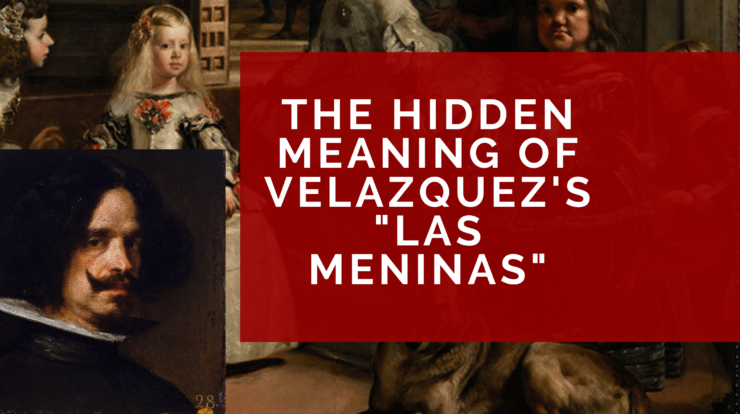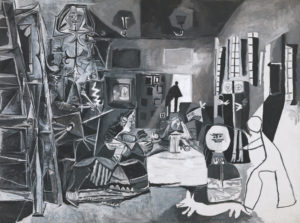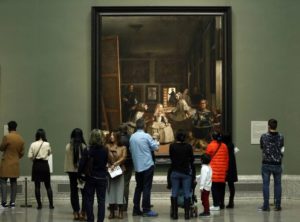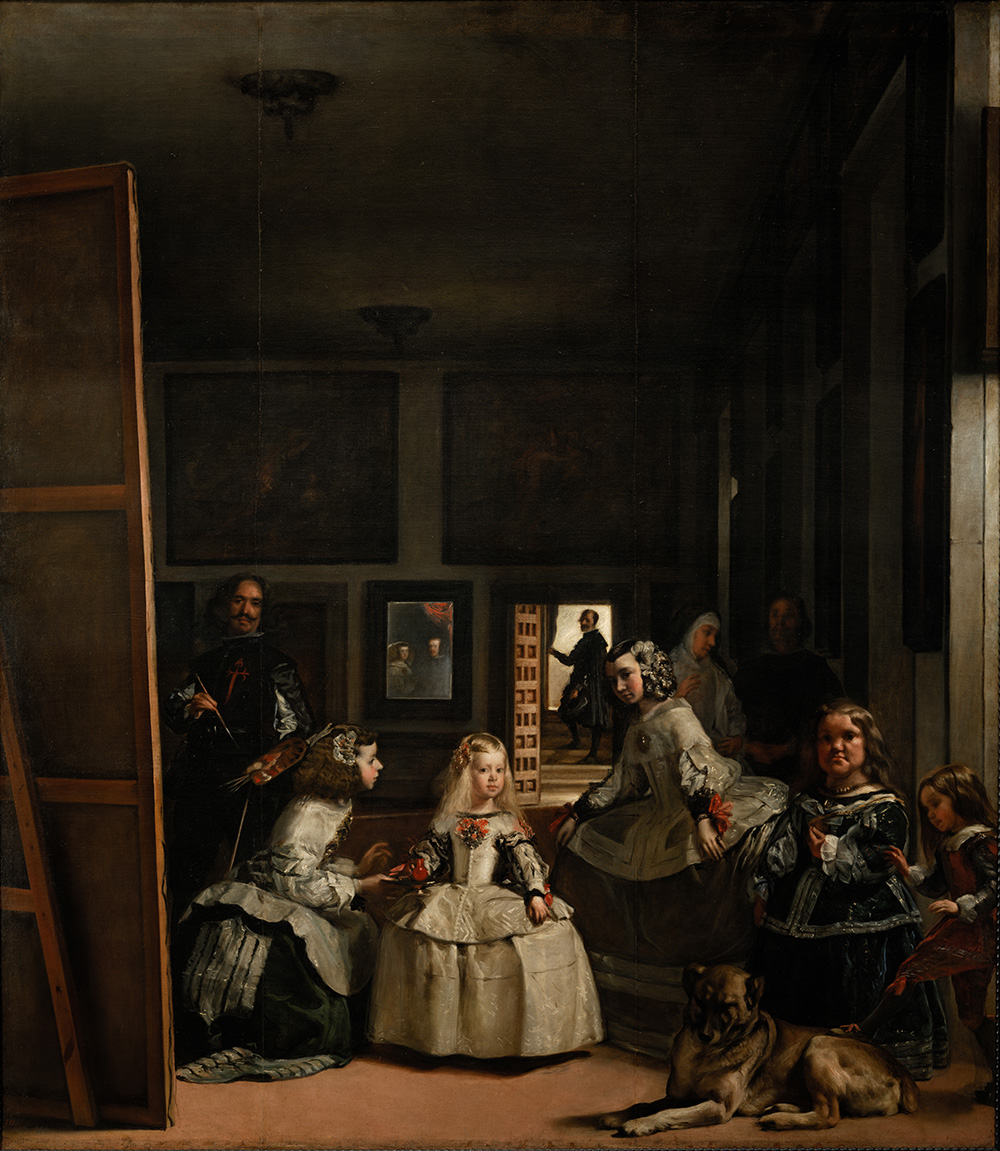
The Painting
Diego Velazquez’s “Las Meninas” is one of the world’s most iconic and well-known paintings. Painted in the mid-17th century, the work is a masterful example of the Spanish Baroque style. The painting features a young girl, Margaret Theresa, the Infanta of Spain. She is surrounded by her ladies-in-waiting, all looking at the viewer. The artist himself is also included in the painting, as are the king and queen reflected in a mirror [this is corrected from the first version of this post when I erroneously said the artist was reflected in the mirror]. The reflection in the mirror indicates that the artist is busy painting the king and queen, while the subject of “Las Meninas” is clearly the Infanta, or the artist himself.
There are many interpretations of this painting, but one common theme is that it reflects the role of art and the artist. The inclusion of the artist in the painting is thought to be a statement of the power of art. By including himself in the painting, the artist elevates himself to the same level as the Infanta. This is a powerful statement on the importance of art and the artist.
Another interesting element of the painting is the use of light and shadow. The light in the painting is said to represent the divine, and the shadow represents the human. This dichotomy is often seen in paintings from this period and is thought to represent the struggle between the spiritual and the earthly.
The painting was controversial when created because it was seen as a departure from traditional portraiture. “Las Meninas” is a complex work that does not fit neatly into any genre. The painting’s use of light and shadow was also unconventional, and some viewers found the work unsettling.
Despite the contemporaneous controversy, “Las Meninas” is widely considered to be Velazquez’s most important work and has been the subject of much critical analysis and interpretation.
The Artist
Velázquez was born in Seville, Spain, in 1599. His father was an artist and taught Diego to paint. Diego’s first known painting, “The Washing of the Feet,” was completed when he was just sixteen years old. He soon became one of the most sought-after painters in Seville. In 1623, Velázquez painted “The Triumph of Bacchus,” which so impressed the king that he summoned the artist to court.
Velázquez spent the next twelve years in the royal palace, painting portraits of the king, queen, and their children, as well as religious and mythological scenes. He also painted a series of large-scale landscapes. In 1656, Velázquez traveled to Italy, where he studied the works of the great masters and was particularly influenced by the work of Titian. He returned to Spain in 1659 and spent the last years of his life painting a series of portraits of Pope Innocent X.
Velázquez died in Madrid in 1660, at the age of 61. He was buried in the convent of San Juan Bautista. Velázquez was one of the most important painters of the Spanish Golden Age, and his work significantly impacted the development of Western art.
Ongoing Influence

Many artists have been influenced by “Las Meninas.” Salvador Dali created a stereoscopic, surreal interpretation of “Las Meninas.” Pablo Picasso created a series of paintings based on the work, which he began in 1957. Francis Bacon also produced a number of variations on the theme.
“Las Meninas” continues to be a source of inspiration for artists today. Its complex composition and use of light and shadow continue to fascinate and challenge those who view it.
Where to See Velazquez’s Masterpiece

The painting is on display at the Museo del Prado in Madrid, Spain.
Read more: https://en.wikipedia.org/wiki/Las_Meninas
What do you think of “Las Meninas”?
What do you see as the most important message that Velazquez was trying to convey in “Las Meninas”? What is the significance of the artist being included in the painting? Have you ever created artwork to share a message or insight? Have you seen “Las Meninas” in person? If so, what was the impact of the painting? Share your thoughts in the comments below.

I have seen both the Velaquez “Las Menians” at the Prado and the Picasso “Las Menians” at the Museu Picasso. Both paintings are amazing!
My interpretation of the painting is a day in a life of the Royal family though the eyes of the King and Queen of Spain. Their reflection can be seen in a mirror at the back of the room. Does this mean as viewers of the painting we become Royals?
I’m not sure how to comment directly on this site so I’m going to piggyback on yours. My husband and I both remember both paintings which we saw 20 years ago. I’m so proud of the fact that I took my children to art museum at a young age because my son, at 18, dragged his grandparents and cousins to see the Prado and was fascinated by these paintings.He still remembers them and is 40. I didn’t know until this article was they were the same subjects. Once I read this it was easy to see and once again a Picasso fascinated me.
I keep rereading the first paragraph and looking at the painting, wondering what I missing. I do not see anyone reflected in a mirror. I see the artist on the left in front of a huge canvas. In the back, I see a man in a doorway climbing some stairs. Am I missing something, or is this a description of another work?
There is a small black framed rectangle just above the Infanta’s head which has two indistinct figures “facing” out. That is the mirror. It is very obscure but the point of the painting.
Everyone except the distracted young girl facing the Infanta is looking straight out of the picture plane in a frozen moment at the King and Queen.
This is a serious point whichI will comment on separately.
I hope this helps a bit.
I see a painted portrait instead of a mirror.
My understanding was that the figures in the mirror are the King and Queen. One more interesting little tidbit about this piece is the emblem on Velazquez’s chest. It was not in the original painting which he finished in 1656. It symbolizes his knighthood which he got in 1659. He had to go back into the painting and paint it in after the fact. So, I think after all interpretation is done, the painting is really about Velasquez himself.
Exactly right James – I’ve corrected my post to reflect this.
No one has mentioned the nun who is the only figure not facing the infatata. My interpretation is the importance of political over religion in this painting. Could it reflect the culture of that time?
Thank you for that fact.
This painting is an unforgiveable insult if you think about it.
As a court painter, Valazquez was tasked with rendering the Royal Images.
It is assumed they would be presented according to their stature (assumed or real).
What Valazquez did, among other things, was to render them obscure and small.
He also made them not the focus of the painting but the center of the attention of the gathering, which in a normal Royal Image painting would be on the other side of the picture plane.
Cleverly, he made three paintings. The first was of the Infanta and her entourage. The detail and lighting are carefully contrived and exquisitely executed as only Valazquez could do. It commands most of the canvas.
The second painting is his self-portrait. It is carefully created to be obscured by shadow but also by brushwork. It takes up much of the left side of the painting.
The third painting is the insult. It is the “miniature” in the mirror at the far back wall of the large and spacious room, and has jus enough detail to identify two people. They are Valazquez’s employers and benefactors. Additionally, to get the Royal Image, he had to de-throne and make invisible the King and Queen.
He escapes with his life and builds an ironclad safety net because officially this is a portrait of the Infanta.
It is a brilliantly conceived, couragious, dangerous painting.
Apologies for the length. In summary- every art work as a story to tell.
One thing more. The Infanta and her entourage came into the room where Valazquez was painting the Royal Portrait. This makes the “insult” even deeper when you think about it. Valazquez made the interruption the subject of this painting.
Very interesting information.
Thank you for that important information.
I agree with the comments above. To me the work is a self portrait. The artist is Valazquez himself at work in his studio in this painting. This is how he sees himself and wants to be remembered. He made the Infanta as the focus to emphasize the importance of his work ( i.e. He paints the king’s family) and demonstrates how skilled he is in doing so by presenting her with his finest ability.
I truly like your RedDotBlog about historical art. It tweeks my interest of the art you bring to light and indulge myself in reading about other information online. Thanks for expanding my knowlege base.
That lots of paintings from the same period have the same use of shadow and light is a very keen observation. I wonder if Velazquez was the pioneer of the technique and was the one who caused that trend? Much like Pearl Jam started the whole grunge trend of musicians in the 1990s.
The painting as a whole and the postures of the figures reminds me of that famous photograph of The Sopranos.
My understanding of the painting is that the entire thing was painted by looking into a mirror. Reading about Durer’s work, he also painted a magnificent portrait of himself by viewing himself in a convex mirror.
It is difficult enough to paint something looking directly at it—but then a mirror? and everything is reversed!
Interesting thoughts.
Yes, based on Valazquez position in the room he must have been looking into a large mirror. Otherwise the painting would be showing the backsides of Las Meninas and her ladies in waiting.
This is a painting that has been written about many, many times; talked about, and numerous artists were influenced by it.
I had the privilege of seeing it at the Prado a few years ago. Yes, impressive, but not awe inspiring .
My eye is immediately drawn every time I see this painting over the years to the figure in the doorway of Don Jose de Nieto Velázquez, the Queens Chamberlain at that time and possibly a relative of the artist. I believe that he’s possibly had an affair with the Queen and potentially could have fathered a child with her and was painted in such a manner looking back at her forlornly to reflect that. If you examine the body language of all the central figures in the painting including the artist himself their heads and hands in some cases are tilted towards Don Jose..and a direct line down from his outstretched arm leads to the five year old Infanta Margaret Theresa, apparently at that time the only surviving child of the King and Queen. Maybe Don Jose was her father and obviously it could not be mentioned in public then if ever so Velazquez insinuated it in a painting instead.
The primary reason this artwork has inspired so very many artists is its technical structure. Its purpose was to soothe the heart of the King by showing and him all the people around him who supported and loved him – and to remind him of the great importance of artist, Velasquez, himself, who had been with him for thirty three years – a very long time and wanted to exalt his own position. Many of the people are family, a guard for protection and safety, and they are, through pictorial devices, looking at the King. The others in the work are not. They are in secondary positions of importance and also to fill in the composition.
The technical composition is remarkable. An analysis shows that it is in quarters horizontally, in 7ths vertically, and has an X shape in the foreground, with Margaret Theresa at its center. Additionally, there are double arcs of light and dark that guide the eye’s focus. And, there are all of those frames! My goodness – the room itself is one frame; there are framed canvases everywhere in the space; the painting is framed; the door is a frame; the mirror is framed. And all of these inexorably force the eye into the open space and onto the precious, glowing little girl. Without missing the important artist at the left, of course. One very fine artist I know says the structure is 3 basic compositions merged together. I somehow doubt that. At this point in his career, Velasquez was capable of merely feeling his way through a masterwork and having it come out perfectly balanced, perfectly accomplished, and to his greater acclaim.
In addition to all the above – I am left wondering who the figure on the stairs, in the background is? Small and yet beautifully highlighted I felt some kind of statement was being made. I have found an explanation online (too much to write here) – but it was slightly prosaic for my imagination. But I love how Velasques has left us wondering with these mysterious details.
Just a little humorous observation from the perspective of a former school teacher. I think the artist could be telling a funny or ironic story here about a petulant child, jealous of attention given to anyone but her. The setting is clearly a portrait session. The subjects of the portrait are the King and Queen. The child, although in the spotlight is getting the least attention from others in the painting. So the spotlight could be the Velasquez’s way of showing the child’s egocentric view of herself. The young woman to the left of the her seems to be entreating her about something, but the child is fixated on her parents…and does NOT look pleased. Is she indignant because she is not in the portrait too? The artist, as artists most often are, is immersed in the process and not paying attention to the child at all. The shadowed figures in the back right seem to be engaged in secret conversation, either about the portrait or about the behavior of the child. The older lady-in-waiting appears to be ignoring her. The King and Queen, because they are sitting for the portrait, are powerless to correct their offspring. The fellow on the stairs seems to be leaving…perhaps the child’s tutor disgusted with the lack of parental control?
If…..and I do say IF…this is the case, then the artist was taking a serious risk here.